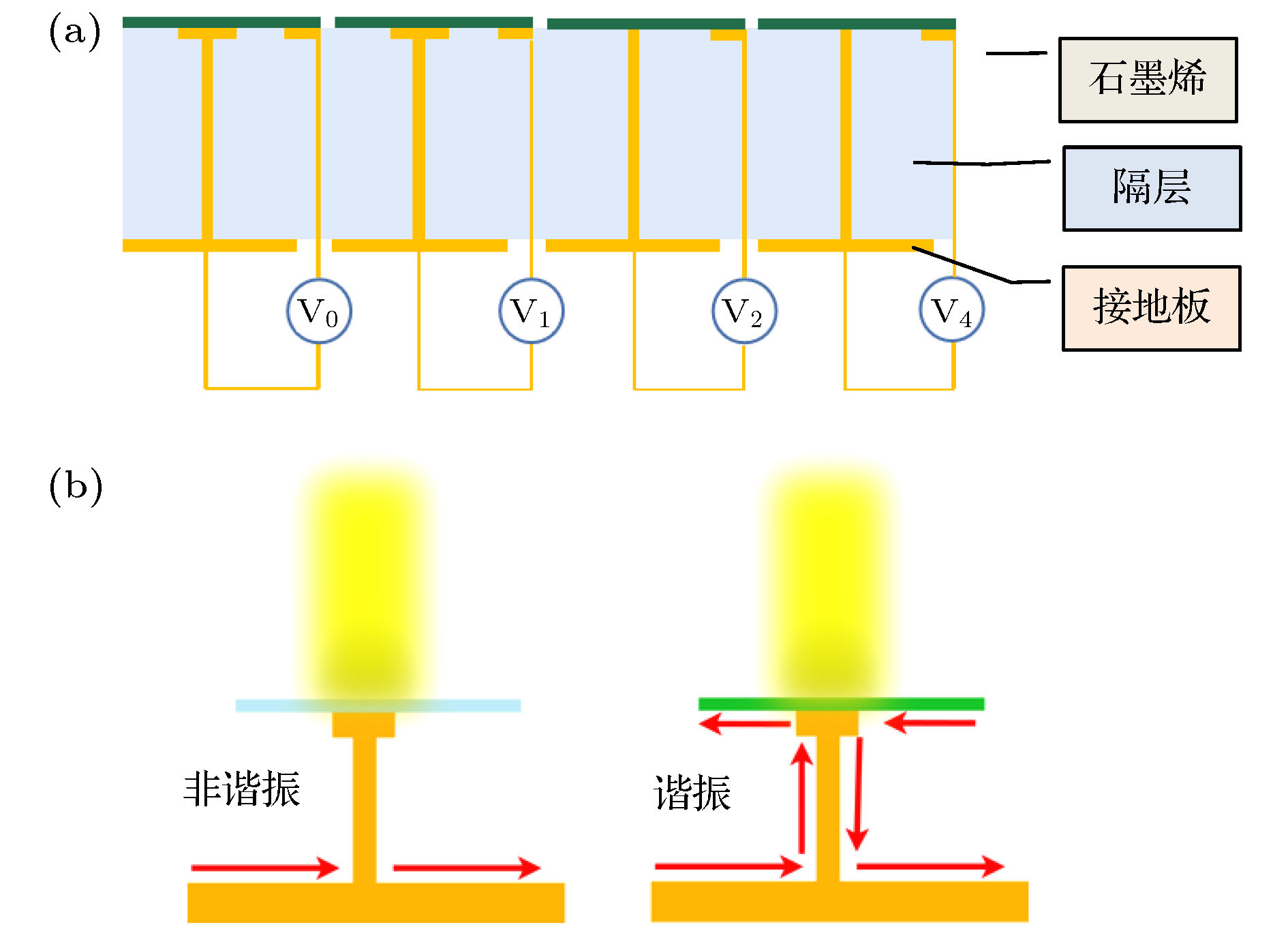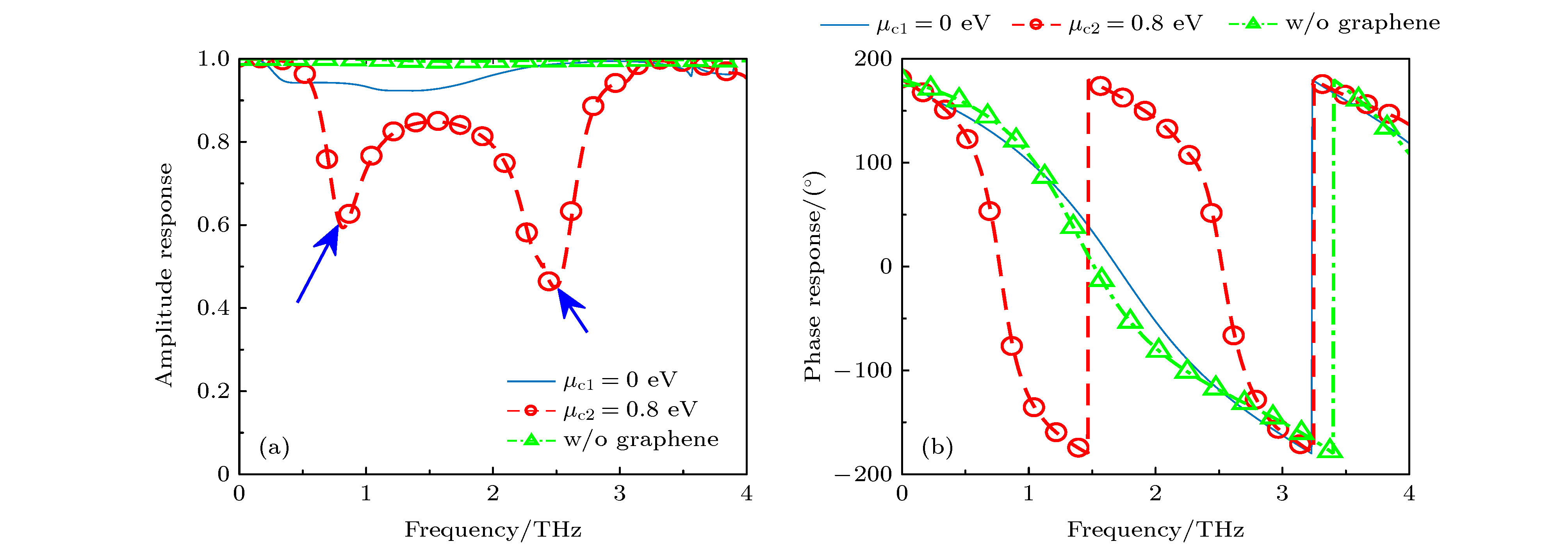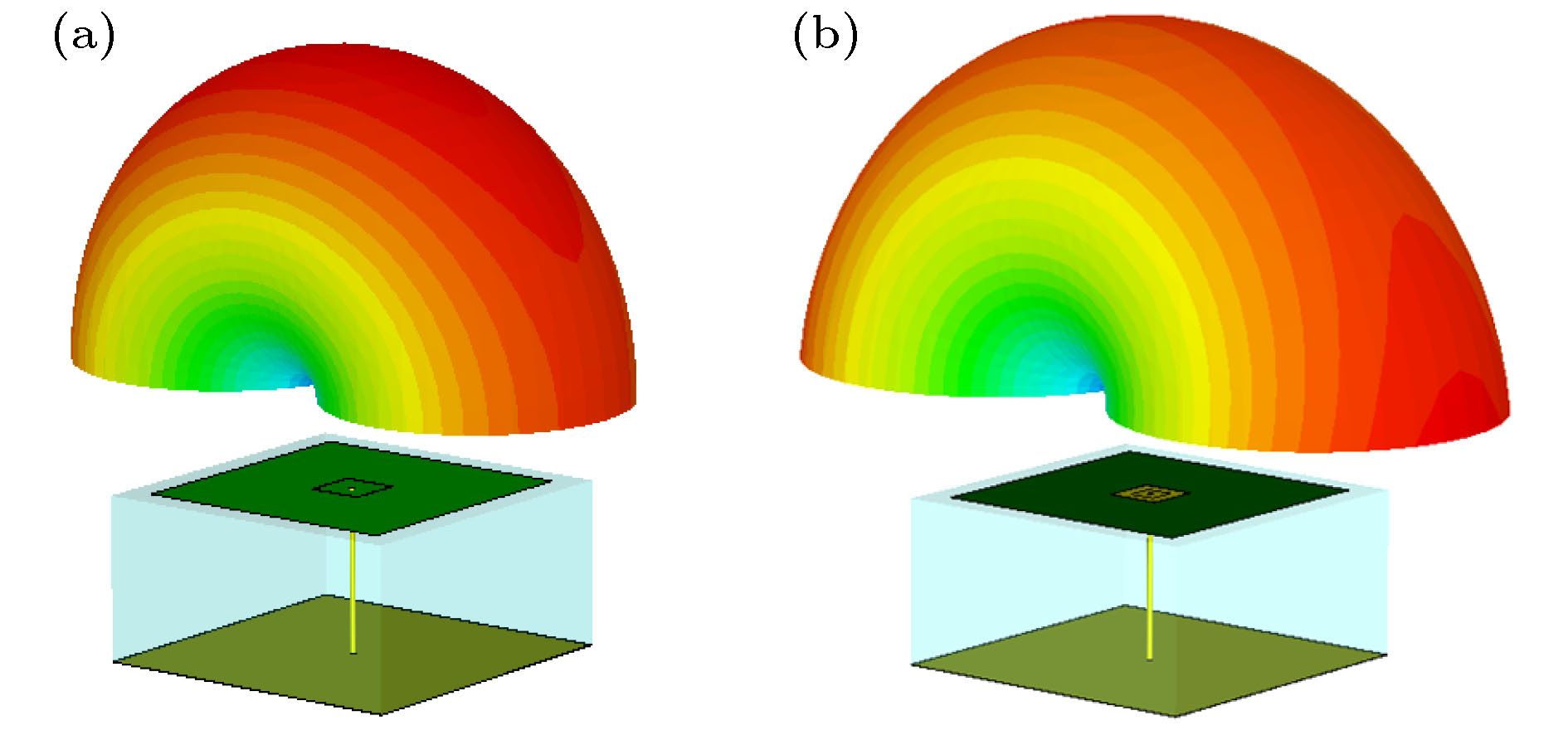-
漫反射电磁表面能够提高目标被探测的难度, 实现电磁消隐的功能. 太赫兹漫反射电磁表面有望在下一代雷达与通信场景中作为一种智能隐身蒙皮使用, 具有广阔的应用前景. 本文利用石墨烯在太赫兹频段优异的电磁可调特性, 并基于谐振模式的开关机理设计了一种反射场具有反相位的石墨烯/金属协同单元结构, 且相位的切换由偏置电压动态控制. 另一方面, 不同于金属材料, 石墨烯具有不可忽略的损耗特性, 导致了所设计的结构在谐振/非谐振两种反相位状态对应的反射幅度不一致, 根据场的干涉与叠加原理, 其不利于远场相干相消, 难以获得理想的漫反射效果. 本文提出了一种将反相位单元结构进行二次组合形成“分子”结构的方法, 并将其作为反射表面的基本元素, 进而运用粒子群算法, 优化“分子”结构的排布方式. 计算结果表明, 使用这种方法设计的动态漫反射表面, 具有收敛速度快、远场峰值小的优势.Electromagnetic diffusion surface can reduce the radar cross section, thus profiting stealth of targets. Terahertz diffusion surface has a wide prospect in the field of next-generation radar and communication, promising to act as a kind of intelligent smart skin. In this paper, utilizing the excellent tunable properties of graphene in the terahertz band, a hybrid structure of graphene and metal which has inverse phase response of reflecting waves is proposed. The reflection phase switches in the mechanism of resonant modes and can be controlled efficiently by the bias voltage. Meanwhile, unlike metal materials, graphene has a non-negligible loss characteristic, which leads the response amplitudes corresponding to the two different switching states to be inconsistent with each other. According to the interference and superposition principle of electromagnetic field, it is not conducive to eliminating the coherent far-field, leading to an unsatisfactory diffusion result. In this paper, we present a “molecular” structure by secondary combination of the above-mentioned reverse phase element states, and take it as the basic element of the diffusion surface. Finally, we use particle swarm optimization to optimize the arrangement of “molecular” structures. The final diffusion surface consists of a combinatorial design of “molecules” rather than randomly distributed reflection units. In addition, molecules designed artificially have similar amplitude responses but different phase responses, which improves the convergence speed and reduces the computation quantity during algorithm evolution. The method of designing molecular structure, described in this paper, is simple, rapid and widely applicable, which effectively improves the amplitude-to-phase modulation ability of graphene metasurface against electromagnetic waves. When diffuse reflection optimization is applied to most of graphene metasurfaces, the method described in this paper can achieve the results that are the same as or even better than the results after a large number of iterations of traditional particle swarm optimization in the most computation-efficient manner. The results show that the dynamic diffusion surface designed by this method has the advantages of fast convergence speed and small far-field peak.
-
Keywords:
- graphene /
- terahertz /
- diffuse reflection /
- particle swarm optimization
[1] Zhao J, Cheng Q, Wang X K, Yuan M J, Zhou X, Fu X J, Qi M Q, Liu S, Chen H B, Zhang Y 2016 Adv. Opt. Mater. 4 1773
 Google Scholar
Google Scholar
[2] Benz A, Krall M, Schwarz S, Dietze D, Detz H, Andrews A M, Schrenk W 2014 Sci. Rep. 4 4296
 Google Scholar
Google Scholar
[3] Nagatsuma T 2011 IEICE Electronic Exp. 8 1127
 Google Scholar
Google Scholar
[4] Federici J, Moeller L 2010 J. Appl. Phys. 107 111101
 Google Scholar
Google Scholar
[5] Alves F, Grbovic D, Kearney B, Karunasiri G 2012 Opt. Lett. 37 1886
 Google Scholar
Google Scholar
[6] Iwaszczuk K, Strikwerda A C, Fan K, Zhang X, Averitt R D, Jepsen P U 2012 Opt. Express 20 635
 Google Scholar
Google Scholar
[7] 李思佳, 曹祥玉, 高军, 郑秋容, 陈红雅, 赵一, 杨群 2013 62 194101
 Google Scholar
Google Scholar
Li S J, Cao X Yu, Gao J Z, Qiu R Z, Yi Y Q 2013 Acta Phys. Sin. 62 194101
 Google Scholar
Google Scholar
[8] Cheng C W, Abbas M N, Chiu C W, Lai K T, Shih M H, Chang Y C 2012 Opt. Express 20 10376
 Google Scholar
Google Scholar
[9] Zhao Y, Cao X, Gao J, Sun Y, Yang H, Liu X, Zhou Y, Han T, Chen W 2016 Sci Rep 6 23896
 Google Scholar
Google Scholar
[10] 闫昕, 梁兰菊, 张雅婷, 丁欣, 姚建铨 2015 64 158101
 Google Scholar
Google Scholar
Yan X, Liang L J, Zhang Y T, Ding X, Yao J Q 2015 Acta Phys. Sin. 64 158101
 Google Scholar
Google Scholar
[11] Cui T J, Qi M Q, Wan X, Zhao J, Cheng Q 2014 Light-Sci. Appl. 3 218
 Google Scholar
Google Scholar
[12] Liu X, Gao J, Xu L, Cao X, Zhao Y, Li S 2017 IEEE Antennas Wirel. Propag. Lett. 16 724
 Google Scholar
Google Scholar
[13] Zhang H, Lu Y, Su J, Li Z, Liu J, Yang Y 2017 Electron. Lett. 53 187
 Google Scholar
Google Scholar
[14] Zhao J, Cheng Q, Wang T Q, Yuan W, Cui T J 2017 Opt. Express 25 1050
 Google Scholar
Google Scholar
[15] Sui S, Ma H, Lv Y, Wang J, Li Z, Zhang J, Xu Z, Qu S 2018 Opt. Express 26 1443
 Google Scholar
Google Scholar
[16] Zhuang Y, Wang G, Liang J, Zhang Q 2017 IEEE Antennas Wirel. Propag. Lett. 16 2606
 Google Scholar
Google Scholar
[17] Qiu L, Xiao G, Kong X, Xiong C 2019 Opt. Express 27 21226
 Google Scholar
Google Scholar
[18] Gao L H, Cheng Q, Yang J, Ma S, Zhao J, Liu S, Chen H, He Q, Jiang W X, Ma H F 2015 Light-Sci. Appl. 4 324
 Google Scholar
Google Scholar
[19] Wang J, Lu W B, Li X B, Liu J L 2016 IEEE Photonics Technol. Lett. 28 971
 Google Scholar
Google Scholar
[20] 李小兵, 陆卫兵, 刘震国, 陈昊 2018 67 184101
 Google Scholar
Google Scholar
Li X B, Lu W B, Liu Z G, Chen H 2018 Acta Phys. Sin. 67 184101
 Google Scholar
Google Scholar
[21] 张银, 冯一军, 姜田, 曹杰, 赵俊明, 朱博 2017 66 204101
 Google Scholar
Google Scholar
Zhang Y, Feng Y J, Jiang T, Cao J, Zhao J M, Zhu B 2017 Acta Phys. Sin. 66 204101
 Google Scholar
Google Scholar
-
表 1 传统PSO算法与本文提出的方法的效果对比
Table 1. Effect comparison between the traditional PSO and the proposed method in this paper.
阵列
规模传统PSO 本文方法 远场峰
值/(V·m–1)优化效
率/dB远场峰
值/(V·m–1)优化效
率/dB9 × 9 10.08 –16.80 6.72 –21.00 18 × 18 27.60 –20.74 19.60 –23.71 27 × 27 45.00 –23.54 34.00 –25.97 表 2 传统PSO算法与本文提出的方法的粒子分布比较
Table 2. Particle distribution comparisons between the traditional PSO and the proposed method in this paper.
阵列规模 粒子方差 粒子均值 传统PSO 本文方法 传统PSO 本文方法 9 × 9 1.12 0.19 11.34 7.09 18 × 18 2.04 1.65 28.45 21.67 27 × 27 28.69 10.25 49.57 38.04 -
[1] Zhao J, Cheng Q, Wang X K, Yuan M J, Zhou X, Fu X J, Qi M Q, Liu S, Chen H B, Zhang Y 2016 Adv. Opt. Mater. 4 1773
 Google Scholar
Google Scholar
[2] Benz A, Krall M, Schwarz S, Dietze D, Detz H, Andrews A M, Schrenk W 2014 Sci. Rep. 4 4296
 Google Scholar
Google Scholar
[3] Nagatsuma T 2011 IEICE Electronic Exp. 8 1127
 Google Scholar
Google Scholar
[4] Federici J, Moeller L 2010 J. Appl. Phys. 107 111101
 Google Scholar
Google Scholar
[5] Alves F, Grbovic D, Kearney B, Karunasiri G 2012 Opt. Lett. 37 1886
 Google Scholar
Google Scholar
[6] Iwaszczuk K, Strikwerda A C, Fan K, Zhang X, Averitt R D, Jepsen P U 2012 Opt. Express 20 635
 Google Scholar
Google Scholar
[7] 李思佳, 曹祥玉, 高军, 郑秋容, 陈红雅, 赵一, 杨群 2013 62 194101
 Google Scholar
Google Scholar
Li S J, Cao X Yu, Gao J Z, Qiu R Z, Yi Y Q 2013 Acta Phys. Sin. 62 194101
 Google Scholar
Google Scholar
[8] Cheng C W, Abbas M N, Chiu C W, Lai K T, Shih M H, Chang Y C 2012 Opt. Express 20 10376
 Google Scholar
Google Scholar
[9] Zhao Y, Cao X, Gao J, Sun Y, Yang H, Liu X, Zhou Y, Han T, Chen W 2016 Sci Rep 6 23896
 Google Scholar
Google Scholar
[10] 闫昕, 梁兰菊, 张雅婷, 丁欣, 姚建铨 2015 64 158101
 Google Scholar
Google Scholar
Yan X, Liang L J, Zhang Y T, Ding X, Yao J Q 2015 Acta Phys. Sin. 64 158101
 Google Scholar
Google Scholar
[11] Cui T J, Qi M Q, Wan X, Zhao J, Cheng Q 2014 Light-Sci. Appl. 3 218
 Google Scholar
Google Scholar
[12] Liu X, Gao J, Xu L, Cao X, Zhao Y, Li S 2017 IEEE Antennas Wirel. Propag. Lett. 16 724
 Google Scholar
Google Scholar
[13] Zhang H, Lu Y, Su J, Li Z, Liu J, Yang Y 2017 Electron. Lett. 53 187
 Google Scholar
Google Scholar
[14] Zhao J, Cheng Q, Wang T Q, Yuan W, Cui T J 2017 Opt. Express 25 1050
 Google Scholar
Google Scholar
[15] Sui S, Ma H, Lv Y, Wang J, Li Z, Zhang J, Xu Z, Qu S 2018 Opt. Express 26 1443
 Google Scholar
Google Scholar
[16] Zhuang Y, Wang G, Liang J, Zhang Q 2017 IEEE Antennas Wirel. Propag. Lett. 16 2606
 Google Scholar
Google Scholar
[17] Qiu L, Xiao G, Kong X, Xiong C 2019 Opt. Express 27 21226
 Google Scholar
Google Scholar
[18] Gao L H, Cheng Q, Yang J, Ma S, Zhao J, Liu S, Chen H, He Q, Jiang W X, Ma H F 2015 Light-Sci. Appl. 4 324
 Google Scholar
Google Scholar
[19] Wang J, Lu W B, Li X B, Liu J L 2016 IEEE Photonics Technol. Lett. 28 971
 Google Scholar
Google Scholar
[20] 李小兵, 陆卫兵, 刘震国, 陈昊 2018 67 184101
 Google Scholar
Google Scholar
Li X B, Lu W B, Liu Z G, Chen H 2018 Acta Phys. Sin. 67 184101
 Google Scholar
Google Scholar
[21] 张银, 冯一军, 姜田, 曹杰, 赵俊明, 朱博 2017 66 204101
 Google Scholar
Google Scholar
Zhang Y, Feng Y J, Jiang T, Cao J, Zhao J M, Zhu B 2017 Acta Phys. Sin. 66 204101
 Google Scholar
Google Scholar
计量
- 文章访问数: 7633
- PDF下载量: 103
- 被引次数: 0














 下载:
下载:







